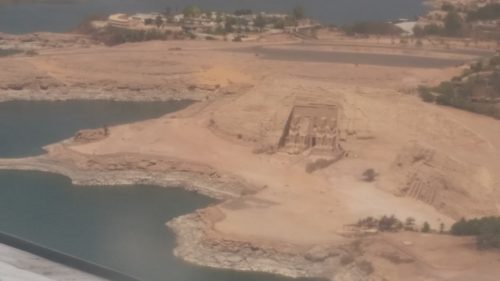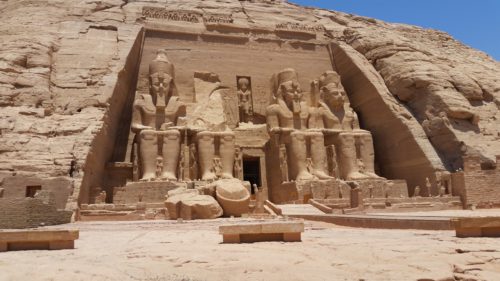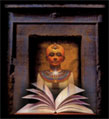July 14th: Abu Simbel.
Whew!!!

I could really just sum up the group’s experience with this great architectural and engineering feet with those three words. Abu Simbel is amazing, in the classic sense of the word. Even the view from the plane, from hundreds of miles in the air, is breath-taking. Truly a sight to behold.
When one comes upon the temple complex – including two temples that are part of what is known as “the Nubian Monuments” – after rounding a mountain, s/he is (again) literally taken aback by it’s splendor and scale: four enormous near 70 ft statues of Rameses II.
Carved out of a mountainside close to the 2nd cataract of the Nile off Lake Nasser, near the Sudan border, the site was constructed for the 18th dynasty monarch in the 13th century BCE.

I was the last of the group to go inside because I was just so awed by its enormity and excellence, not just from an architectural and engineering perspective, but also by the astrological and geological mastery that went into it as well.
Abu Simbel was originally aligned in such a way that the rays of the sun would illuminate sculptures of Rameses II on February 21 and October 21, the dates of his birth and coronation, respectively.
And despite being dismantled and moved from its original location in 1968 to save it from flooding as a result of the Aswan High Dam, Abu Simbel’s impressiveness still shines through.
The second temple on the site is dedicated to the goddess Het-Heru (Hathor) and to Queen Nefertari, Rameses II’s wife. Like the main temple, four enormous statues (just over 30 feet each) stand powerfully outside. However, they not only depict Nefertari, but also Rameses.
This temple is distinct because it 1: is the second temple that was dedicated to a queen and 2: represents second time in Kemet that a queen was artistically depicted in equal proportion to the king.
I did say that this place is awesome, right?
The next day, we toured the Temple of Edfu, dedicated to the god Heru (Horus), and Kom Ombo. Built in the third century BCE during the Greek occupation, the temple of Edfu explores the Ausarian myth, detailing the saga of Ausar (Osiris), Auset (Isis) and Heru (Horus).
Despite being closed as a temple in 391 CE and subsequently defiled by Christian zealots in the ensuing years, I still felt the spiritual potency there at Edfu.

Statue of Heru at Edfu temple
Kom Ombo was also built during the Ptolemaic (Greek) period (second century BCE) and features a unique double temple, dedicated to Sobek, the crocodile god of war and fertility, and Heru. One of the features that I found quite interesting at this temple is the Medu Netcher (hieroglyphics) that displays medical instruments that were used by Imhotep, many of which are still in use today, 5000 years later.
I love the temples of Ancient Kemet. They always give me the chance to make deep, spiritual connections that I can take with me, manifest and share with those closest to me on my life’s journey. Abu Simbel, Edfu and Kom Ombo were the perfect set up for the next two temples that we visited, Luxor and Karnak.



